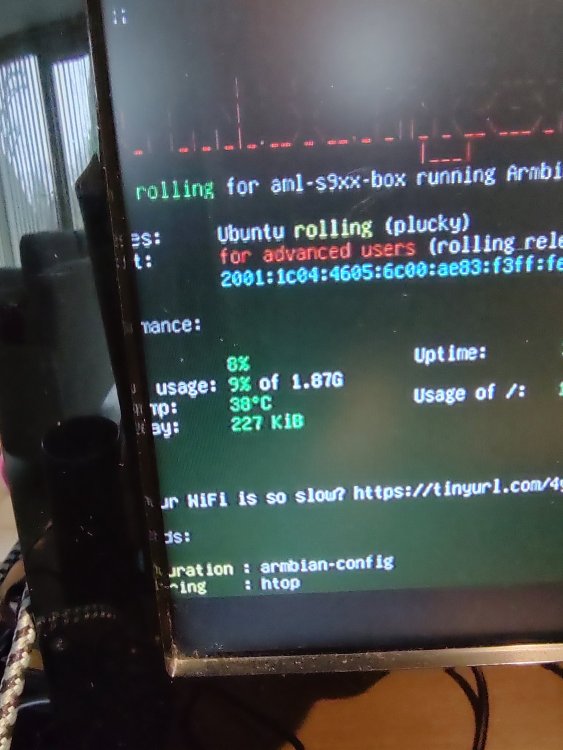All Activity
- Past hour
-
Thanks for your help. I will stay with the bookworm image, it works, that's fine.
- Today
-
I looked into the image Armbian_25.11.1_Rock-5b-plus_noble_vendor_6.1.115_gnome_desktop.img It is NOT Trixie, but it is new and prominent one, comments below the download picture are 1 year old so outdated Please state what image you use. Anyway that noble 25.11.1 one is: DTB is explicitly 5b-plus, so that is OK, still name presented I would also think/prefer 5B+ U-Boot SPL 2025.10_armbian-2025.10-Se50b-P0eb7-Hdbe0-Vfd58-Bbf55-R448a (Nov 24 2025 - 08:35:51 +0000) So U-Boot is mainline but kernel is vendor 6.1.115, that does not work I think. On my ROCK5B, I use EDK2-UEFI v1.1 and I need to change a setting in it so it can boot 6.1.115. Standard is mainline (6.10 or later I think). That standard modern/mainline (v1.1 release is from april 2025) with 6.1.115 does not work, it locks up halfway kernel load or so. So this Image can't work I think. It can be changed to mainline kernel, in container or so, could do it right now locally on my computer, but does not make sense for anyone else. If you want Trixie, so debian13, you might take the one with kernel 6.18. I am using that on NanoPi-R6C and saw no issues so far. Of course it lacks various videocodecs etc, but no issue for some webbrowsing and mainly server remote tasks etc. So see want you want to use yours for.
-

Expected default graphics acceleration for RK3588?
gpupoor replied to gpupoor's topic in Orange Pi 5 Plus
Edit: I'm not sure how to format nicely here... so I updated the related PR. That said, this probably isn't the best reference location for this. In any case, posting in case helpful for anyone else. If it's useful for the project to better community (and potentially automate) some of this I'm happy to get involved, but here's what I've got for now: There are fundamentally two driver paths for RK3588: libMali path - Enables NPU for ML inference, basic GPU only Panthor path - Enables full GPU acceleration, no NPU Within each path, you can choose headless or desktop (XFCE/GNOME), but: libMali + desktop = slow rendering (software only) Panthor + desktop = smooth rendering (hardware accelerated) Key insight: The NPU and GPU hardware are separate, but the software drivers conflict. You must choose which accelerator matters more for your use case. Additional constraint: Kernel matters - NPU only works on 6.1 vendor kernel. Mainline 6.12 has no NPU support but best GPU drivers. This creates a matrix of ~6 viable configurations, each optimized for different workloads (production ML, ML development, desktop, latest kernel, etc). More detailed breakdown: https://github.com/armbian/build/pull/8979#issuecomment-3587135022 -

Armbian for H313 X96-Q LPDDR3 TV-Box
Thịnh Nguyễn replied to sicxnull's topic in Allwinner CPU Boxes
Thank you, it booted on tv98 pro clone 1gb ram with assembled + 1gb ram (256x4) -
Collabora will be at Embedded Software Engineering Kongress! Catch our talk as we share our expertise in training large open source models. View the full article
-
It might be related to Trixie (quick test is checking this on Ubuntu variant). We fix few bugs in user space - some packages were missing due to changes in their relations ... if we are talking about hardware RTC, then it is kernel related. Generic kernels usually have only basic support for most boards we are dealing with, but still, this specific function could work different or not at all. Depending of the version and time of build. Hard to say without investigation. I added battery to my N2+ a while ago and tested RTC functionality. It worked, but its a long time ago since I did that test. I will look into this when possible.
-
Nothing happens after that. It freezes there. EDIT: Is it related with that problem?
-
hi, @rollinglabs Have you already had a chance to play with it SBC?
-

Add Devicetree To Grub Automatically: Here's How
Zaerc replied to The Tall Man's topic in Reviews, Tutorials, Hardware hacks
Thank you, I found this information very helpful. I have modified both 10_linux and 30_os-prober in a more fancy way, inspired by AmazingFate's Rockchip Debian live CD. Here are the patches in case anyone is interested... 10_linux.patch 30_os-prober.patch -
I don't see that from the picture; That tells that kernel is running, and started with initramfs, but what happens after that? just stall?
-
@Jeeva Kandasamy depends on which branch you are looking at? V20250306 hasn’t changed much. https://github.com/NickAlilovic/build/commits/v20250306/
-
We provide some very tiny builds that can be run as live system on x86 desktop PC: https://www.armbian.com/uefi-x86/ (i use it on all of my x86 machines)
-
@dale I had the same problem last night. Should be fixed now. Clone or update the repository. You will need to install Docker. https://github.com/NickAlilovic/build/commit/025e4487f87233bfb823c7d51162d877b2a9fd6f https://github.com/armbian/build/issues/8572
-
25.2.3 build fine after upgrade though I had to hold rpi-eeprom, raspi-firmware and raspberrypi-sys-mods Also still getting the Method gave a blank filename apt error
-
This was my original approach. I don't have the knowledge/experience to parse a script like that and is the reason I was asking here.
-
-
Hello there, I have found another problem. My setup: Monitor Samsung syncmaster 2032mw Windoze 10 reports 1280x768 60Hz T95Z plus box cpu amlogic meson(s912)arm cortex-a53 mali t820 gpu dtb used: amlogic/meson-gxm-t95z-plus.dtb everything works including WIFI. But I have overscan in the terminal and in de Cinnamon desktop I am looking for info https://docs.armbian.com/User-Guide_Advanced-Configuration/ enable a custom screen resolution whitin x.org for a resolution when i open a terminal and run xrandr --listmonitors the result is: Monitors: 1 0: +HDMI 1920x1080/90+0+0 HDMI-1 then i type cvt 1628080 1768 but the next command allready result in bash:cvt: command not found Now i am stuck here any tips?
-
It gets problematic if it is only Windows that is available. In the past I advised people to download Knoppix and boot the PC with that so you have full control. But nowadays SecureBoot might already be a showstopper, unless you know how to deal with it. So your best Linux is probably the ROCK5 with Armbian Bookworm. You can use that to edit the Trixie SD-card. Or upgrade bookworm in-place to Trixie, I have done it more than 10 times in 2025H2, still 1 or 2 computers to go.
-
I don't know how to set loglevel to 7 in armbianEnv.txt 😕 On Windows after flashing the SD card, I don't have access to the files (ext4 partition probably). And on my Linux VM I'm not able to mount the SD card 😕
-
From the log I see: Model: Radxa ROCK 5B 272910 bytes read in 34 ms (7.7 MiB/s) I would expect Radxa ROCK 5B+ Or is it 1 DTB nowadays? The bytes read should represent the DTB file that is loaded, I use extlinux so can see what files are loaded, seems this 2025.10 build does not show this. Also be aware it first tries EFI booting, it fails as one can see, so no issue here, but I got confused on my ROCK5B (not the newer upgraded + board) because I had an NVME connectod with a working bootaa64.efi grub.cfg etc as well, so it booted something else than the image from SD-card. I was my own tuned rootfs, so was rather easy to see, but other occasion I did not notice and wasted a lot of time. For this case, what does the kernel spit out ? set loglevel to 7 in armbianEnv.txt
-
Try what? Do I need to guess what "the most current stable Armbian" is ? Best post an URL + sha256sum what you are doing/using. In theory, I could fairly easy merge it into booting in a KVM, it has then properly working (virtual) RTC from the host (ROCK5B or NanoPi-R6C or RPi4B), but likely needs generic Debian Trixie kernel+initrd/(DTB). That can hide potential errors with your hardware, like a dangling wire in your cable or RJ45 connector or duplicate DHCPserver in LAN or worse (criminals). Or you have ethernet time protocol working, various ethernet HW supports it, like on RPi. Or what do you use to manage your network? Recently netplan.io got pushed, that was a disaster for me, such that I banned Ubuntu now.
-
Thanks geoW, I look to be having some success with the 25.2.3 build I just have to see if it survives the ugrades
-
In general it can be done what you want. You just need to understand how Arm SBCs boot/work and Linux in general. Simply stated, it is: ROM -> bootloader -> kernel -> userspace ROM is very specific for the SoC of course, also bootloader is specific as well as the kernel. You can make a kernel that includes all various drivers and methods, like there is for x86 (works with Intel chips and AMD chips). userspace (rootfs) is normally generic, so if you take RPi bootloader+kernel and Libre userspace, it can work. I have done such things several times, but then the other way around: RPi userspace from my 5 years always in-place upgraded rootfs running on Rockchip RK3588 SBCs (Armbian bootloader and kernel). That way no lengthy and boring re-install of all sorts of debian packages and configs tuning etc. Even browser bookmarks are the same then. So very fast up and running with the new SBC. You need to know or start to study the differences in bootloader methods of course. In your case looking into the Libre script/tool would be a good start I think.
-
I confirm, here it is failing setting up openssh service, it starts rebooting after root autologin prompt, tested on rpi5.
-
As suggested by Werner, I have connected my computer to the board over UART. I have got this as output. Not sure if it helps.







